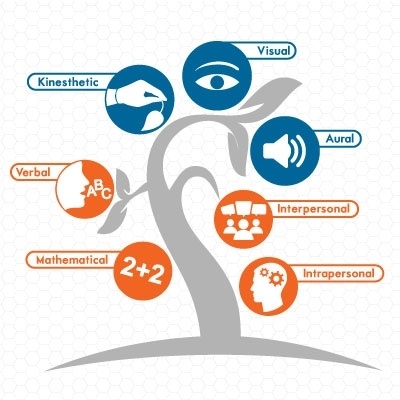How To Create Online Training For Various Learning Styles
The existence of various models, to mark different learning styles, acknowledges the fact that each one of us learns differently.
What Is A Learning Style?
Our learning style is nothing but our preferred approach to learn, or to put it simply internalize, assimilate, process, and then apply. When we go through eLearning or other kinds of training that suits or matches our intrinsic learning style, we are able to learn effortlessly and effectively.
Therefore, there is a clear need for online training to match different learning styles. In this article, we will look at the different learning styles and see what techniques can be used to design eLearning courses (online training) to match different learning styles.
What Are The Different Types Of Learning Styles?
One of the commonly used models to identify key learning styles is the VARK model.
According to this, there are 4 types of learning styles mapping to the following types of learners:
- Visual learners.
As the name suggests, these learners need strong visual cues to learn. In the online training context, they would relate to graphics, animations, videos, and other high-impact visual techniques. - Aural or Auditory learners.
Learners of this profile relate best to audio or voiceover in learning. They find the facilitated sessions (Instructor-Led Training or ILT) to be relevant and would find online versions of these sessions (recordings of ILT/VILT sessions or webinars) to be equally useful. In online training, they would relate to courses that use audio to support the learning path. - Reading learners.
Learners of this profile find simple text-based approach to be most stimulating and relevant. They are at ease with text-only PDFs, presentations, or reference articles. In online training, they prefer higher focus on text and would find audio or high-end visual techniques to be distracting. - Kinesthetic learners.
Learners of this profile rely on their senses to learn. In the realm of training, they need an experiential model to learn. In online training, it would be good to have simulations, what-if analysis, and even breakout sessions wherein learners can actually perform the task or the skill they have learnt.
Why Is It Vital To Offer Training That Maps To Different Learning Styles?
Most eLearning or online training programs are rolled out to very heterogeneous profiles of learners. Online training, therefore, needs to cater to all these primary learning styles. This can be accomplished through a multimodal approach.
Let us look at this challenge in the context of the VARK model and the need to look at a multimodal approach.
- Limitations of VARK model.
I feel that the VARK model can be used as a baseline to arrive at primary categories of learners, but this is far too simplistic. We do not learn through a single approach all the time. - Adopting a multimodal approach.
In reality, it is common to find that we possess a combination of these styles, referred to as multimodal learning. Our preference for a given approach to learning can change depending on the subject (nature of content), our interest, or our proficiency.
Instructional Designers must factor for this multimodal approach to be able to create training that is relevant to diverse learning styles.
How Can You Customize The Online Training Design For Diverse Learning Styles?
As Instructional Designers, we have access to the learning mandate, the business mandate, and key learner aspects (current proficiency, expected gain from the training, etc.). However, we have no data on the learning styles of learners.
More often than not, eLearning courses are rolled out to a rather heterogeneous profile of learners.
What Approach Would Work?
At EI Design, our learning designs use the following approaches to make the online training relevant and interesting for the learners:
- Keep the focus on the learning outcomes and judiciously use all modes of learning.
- Map the most appropriate approach, based on the content and what kind of presentation in the online format would make it appealing to most learners.
- Use varied media formats so that you can hold the interest of learners with different preferences.
- Do progressive build up – Give options to learners ranging from Teach > Show > Practice > Test.
- Provide flexibility to learners by giving them control to choose (Audio vs. transcript or Video with an interactive PDF of the transcript), maintain their pace, and not be overwhelmed by a style that does not work for them.
What Techniques To Use To Customize Online Training Design For Diverse Learning Styles?
To illustrate how these approaches can be applied practically to customize the eLearning to suit different learning styles, let me share two techniques that we use extensively.
1. Use Personalization
Adult learners want control and the flexibility to be able to pick the learning experience, as well as the learning path that is most relevant for them. This is exactly where personalization of eLearning fits in.
You can give control to the learner through the following approaches:
- Level 1.
You can begin the course by offering the learners the opportunity to choose an avatar and the flexibility to do basic level of customization, since they can opt for themes, backgrounds, fonts, and so on. - Level 2.
Here, you allow crucial personalization by enabling the learners to select the format of content delivery that resonates with their learning style. Even if you opted for Audio, having a right balance of On-Screen Text (OST) and easy-to-read transcrip,t that can also be printed as a PDF, helps learners with other learning styles. - Level 3.
Here, you allow the learner to choose the learning, based on their proficiency, which is determined by a pre-assessment, or their interest, which is determined through a survey.
2. Use Microlearning And Learning Paths
As we know, microlearning techniques allow us to control the treatment of each aspect of content at an extremely granular level.
- We can use different techniques for each nugget and use varied presentation formats for each nugget.
- This allows us to create a series of nuggets that use an approach that is most suited for the content. Furthermore, using different formats allows us to keep learners with different learning styles glued.
I hope this article provides cues that you can use to customize eLearning to match the different learning styles of your employees. This will lead to higher employee engagement and will certainly lead to the required performance gain. If you have any specific queries, do contact me at [email protected].
Read More:
- Benefits Of Personalized eLearning – Featuring A Case Study For Instructional Designers
- How Personalized eLearning Engages Learners – Featuring A Case study
- Why Adopt Microlearning – 15 Questions Answered
- How Are Performance Support Tools Different From Training? 3 PST Examples Featuring Microlearning










